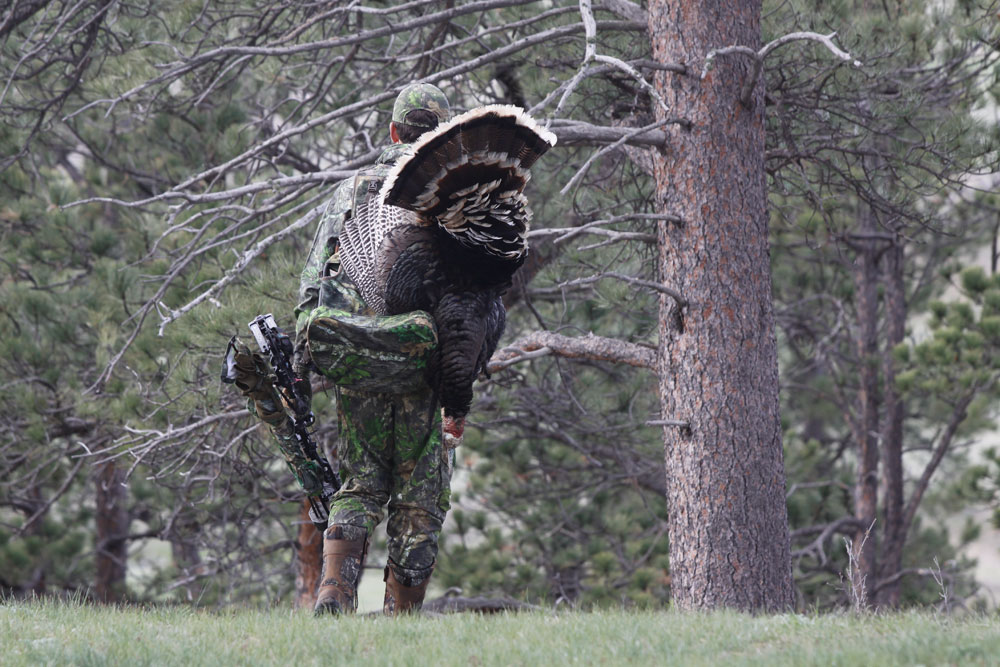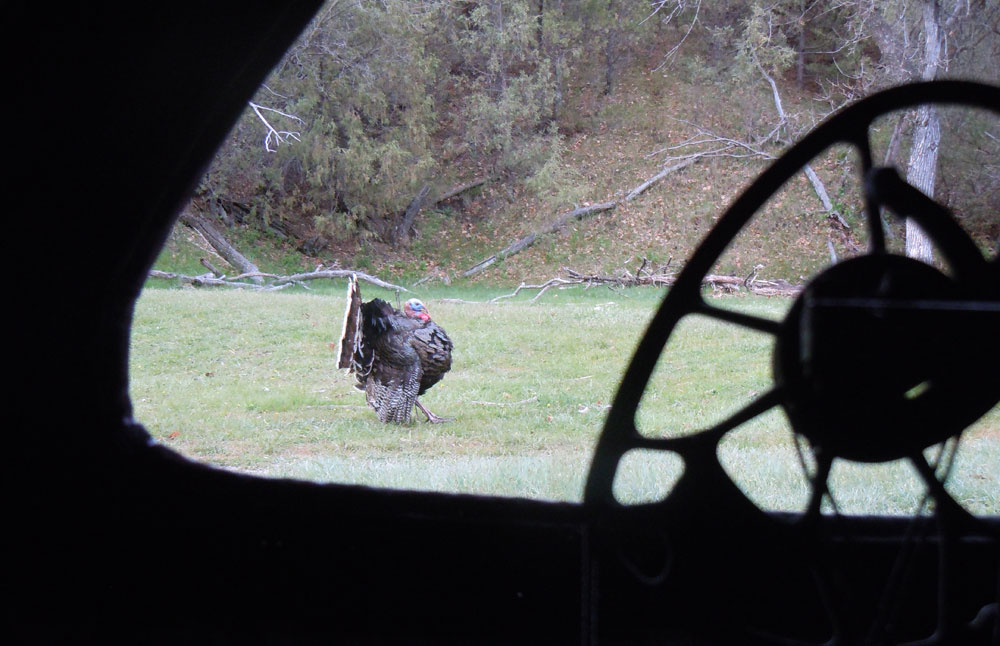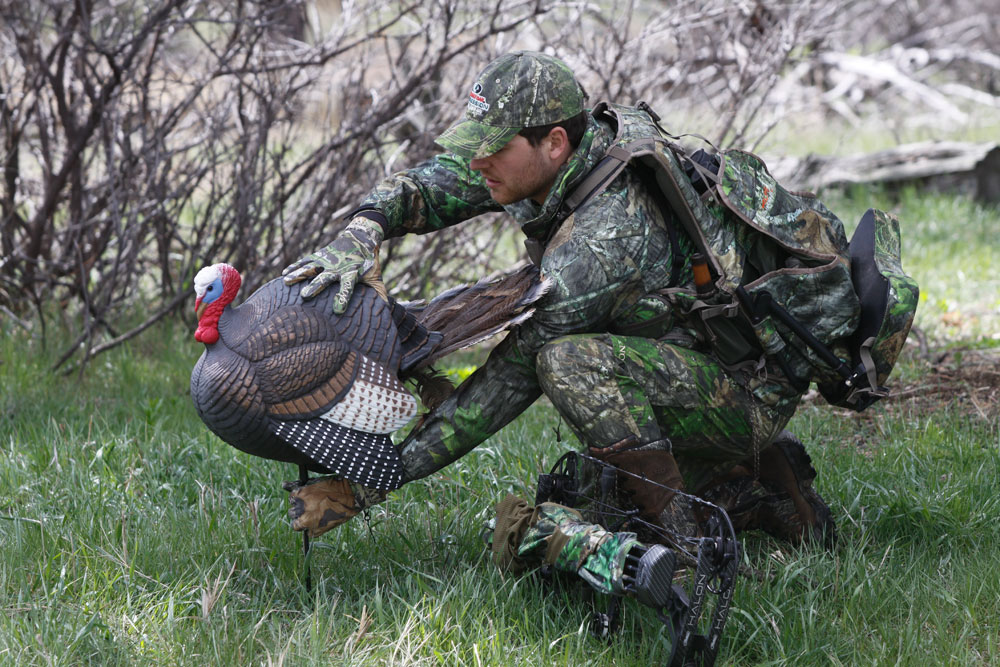article and photos by Mark Kayser

Bowhunting Big Bird, The Turkey
Bowhunting spring turkeys gives you a cure from winter, cabin fever and a challenge to hunt the largest game bird in North America. Although not quite as big as Sesame Street’s Big Bird, a beefy tom turkey can tip the scales at more than 25 pounds. According to the National Wild Turkey Federation, the largest on record is a 37.6-pound goliath taken in Kentucky during the 2015 season. That’s a lot of turkey and the reason you need to have the right gear and a detailed plan for a future turkey dinner.
Bowhunting Turkey Gear
Turkeys may be big for the bird world, but they offer a small target. Gearing up with the right equipment will help you overcome that challenge and other obstacles these sharp-eyed, paranoid fowl create.
You don’t need a powerhouse of a bow to drive an arrow through a turkey, but you do need a shaving-sharp broadhead. A sharp head helps cut through a Kevlar vest of turkey feathers and pierce vitals. A few talented archers have used blunts to smack a turkey in the noggin, but if you think a head shot is in your future, a better option would be a broadhead with a wide cutting diameter.
Many companies now manufacture broadheads with a cutting diameter exceeding two inches and several have expandable broadheads that open up to three inches or more when deployed. These specialized designs increase your odds of hitting the head of a turkey, reminiscent of a William Tell apple shot. If you do connect, there is some good and bad news. Tracking will be minimal, but watching a headless turkey flop around could leave you with bad dreams later. A smoked drumstick will make those images disappear quickly.
Another critical piece of gear for most spring turkey bowhunters is a ground blind. Set up a blind near a roost to ambush turkeys at fly down or place it along a field edge for a midmorning rendezvous. Either option combined with a quality ground blind lets you get away with the draw of an arrow undetected. Hub-style blinds like this are quick to deploy, sturdy and conceal your movements.

Another item you can’t overlook is a lifelike turkey decoy. You can go with one decoy, either a tom or a hen, or set out multiple decoys to represent flock living. Avian, Dave Smith Decoys, Primos and others mold, and paint decoys so realistic that turkeys can’t help, but run over to socialize. For the Cadillac in turkey decoys consider a real mounted turkey. I’ve used a Hazel Creek hen decoy for more than a decade with amazing results. Every spring I’m forced to spook jakes off of the sexy hen as they get a little too rambunctious with the lady. I set my decoy up within 10 yards of my blind and turkeys practically trip over the tie-down chords on their mission to engage.
Other important gear includes an assortment of calls. A box call, a slate call and a diaphragm call should be minimum in your call arsenal. You never know what tone a turkey will fire up to and sounding like a flock by using various calls creates the illusion of a party toms don’t want to miss.
Other comfort items include a vest with a padded seat attached. You can stow all of your gear in the multiple pockets to stay organized when the gobbling heat is on. Finally, don’t forget to bring along a rangefinder for precision shots at varying distances and a binocular to scan the woods for turkey activity.
Hunting Strategies For Bowhunting Turkeys
The vital zone of a turkey is approximately the size of a baseball, so strive for close shots. The best solution to look a turkey eye to eye involves a blind, a decoy and patience. First, use a ground blind. Turkeys rarely blink at a camouflaged ground blind even if you put it out the day before. To greet a turkey at sunrise as it flies down from the roost, you need to be in your blind approximately an hour before shooting light. Quietly stake your decoy within 15 yards or less of your blind and slip in to wait for wings to flap.
As the turkeys stir they will begin to yelp. Let them talk amongst themselves, but when you get a sense that the landing zone could be busy, send a few soft yelps their way to direct them to your decoy. Don’t get too aggressive as it could cause hens to fly the opposite direction to avoid competition.
Later in the morning, many turkey flocks visit fields to feed and strut. Stake a decoy and get in your blind before they typically arrive. Decoy setups can vary with a single hen, a strutting tom or a hen wooed by a jake. Be creative as most combinations work when paired with true-sounding calls.
If you just can’t handle a sit-and-wait approach, you can still-hunt turkeys. A blind-free hunt gives you freedom to be where the turkey wants to be with a roaming mindset. Hunt like you would with a shotgun, but when you believe a turkey is approaching you need to stake a decoy fast and fall back to get ready for the shot. Some prefer to be behind a tree so that when a turkey approaches and passes behind the tree you can draw without being seen. Others feel that if a turkey falls for the decoy ruse they’ll be so focused on the plastic that you can draw in full view. Take your pick, but with a real mounted decoy or a realistic plastic model you can lure a turkey in close without using a ground blind.

Bowhunting Turkey Shot Placement
Whether aiming for the head or the heart, the vital zone of a turkey is small. And unlike a big game animal with the vital zone squarely behind the front leg, a turkey’s vital zone isn’t so obvious. A turkey’s characteristically dark and blending feather pattern makes it difficult to aim exactly for the vitals. Shadows, low light and brush can compound your aiming precision. That’s not good since a perfect hit is necessary for recovery. Even if the turkey is bleeding, you’ll be challenged to locate a blood trail with feathers quickly sopping up any miniscule amounts of blood.
Study turkey anatomy if you want to target the vitals. On a broadside turkey you should center your aim on the location where the wing feathers change colors. It’s almost dead center on the body. For a rear shot, aim for the turkey’s anus when a tom is in full strut. If the tail is down, aim for the center of the back to pierce vitals and spine. For a frontal shot, aim for the beard or slightly above it to save your trophy paint brush and still zip the vitals.
A head shot also works, but the target is even smaller at less than three inches for the head or neck. It moves constantly, thus the reason for the innovation of wide broadheads to increase the chance for a hit. Make a direct hit to this region and fire up the stove.
Finally, a few ardent bowhunters aim low and shoot for the thighs. This will anchor a turkey one of two ways. You may hit the large artery feeding through the leg. Severing it will quickly dispatch a turkey like hitting the femoral artery on big game. If you miss that tiny target you’ll probably pierce the leg or thigh. If you break a bone it stops a turkey cold. These big birds need those legs to get airborne and to run away. You’ll have to dispatch the turkey with another shot, but your turkey dinner is guaranteed.
You can manipulate the position of a gobbler for accurate shot placement through decoy setup. Gobblers approach hens from behind for breeding purposes so keep that mental image when positioning a hen decoy. If you like a rear shot, place the decoy facing away. If you like a broadside shot, place the decoy broadside and if you like a frontal shot, position the decoy straight at you.
Bowhunting turkeys is a test of all of your skills including mentally setting up a decoy scenario to fool the wariest of game. It’s also just a great excuse to enjoy spring after a long, cold winter.




























